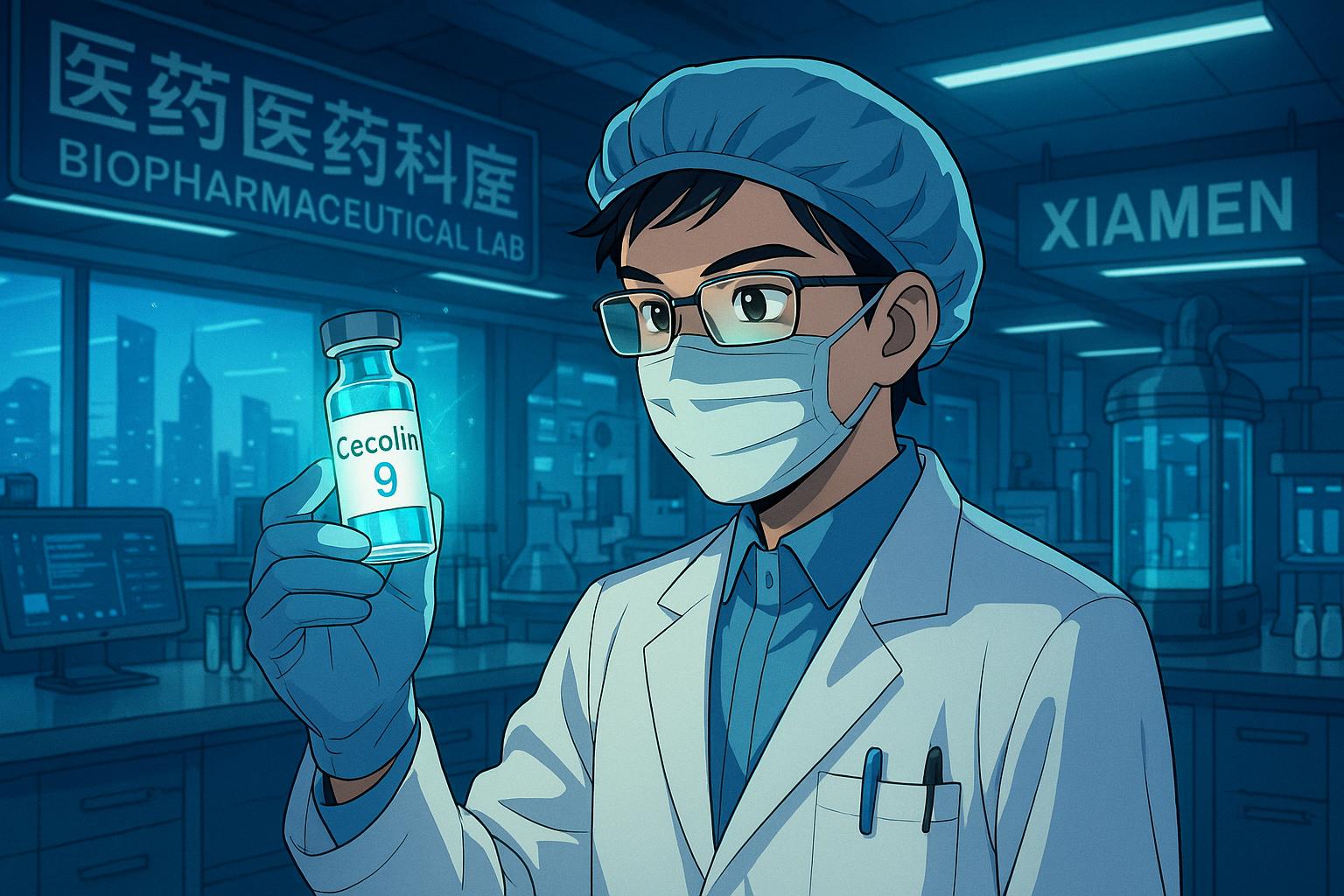Haicang district in Xiamen has gained market approval for three cutting-edge drugs, including Cecolin 9 – China’s first domestic nine-valent HPV vaccine – alongside advancements in growth hormone therapy and antiemetics, strengthening its position as a leading biopharmaceutical hub.
In a significant advancement for China’s pharmaceutical landscape, Haicang district in Xiamen, Fujian province, recently secured market approval for three innovative drugs, positioning itself as a key player in biopharmaceutical development. The approved drugs—Cecolin 9, Pegpesen, and Fosrolapitant and Palonosetron Hydrochloride for Injection—target critical therapeutic areas such as women’s health, oncology, and paediatric growth. This breakthrough aligns with the broader ambition of enhancing domestic innovation capabilities within the flourishing biopharmaceutical sector.
Leading this charge is Cecolin 9, the nation’s first homegrown nine-valent human papillomavirus (HPV) vaccine, a collaboration between Xiamen University and Wantai Bio-Pharm. This vaccine provides essential protection against seven high-risk HPV types linked to cervical cancer, as well as preventing various lesions caused by two low-risk types. By achieving this milestone, China joins the United States in securing independent supply capabilities for high-valency HPV vaccines, effectively breaking the long-standing monopoly previously held by imported brands. The impact of Cecolin 9 could be profound, especially given that HPV is responsible for a substantial proportion of cervical cancer cases globally.
Contributing to the momentum is Pegpesen, an innovative long-acting growth hormone injection introduced by Amoytop Biotech. Targeting children aged three and above, it leverages a unique Y-shaped 40kD polyethylene glycol modification technology, allowing for a once-weekly injection regimen. The company claims that this development could reduce the number of annual injections significantly compared to traditional therapies that necessitate daily doses. Such innovations not only enhance adherence to treatment regimens but also represent a shift toward more patient-centric healthcare solutions.
Additionally, the introduction of Fosrolapitant and Palonosetron Hydrochloride for Injection marks a notable advancement in antiemetic therapy. This formulation is distinguished by its dual receptor antagonism, targeting both NK-1 and 5-HT3 receptors to effectively suppress the vomiting reflex through distinct pathways. The potential for a single injection to manage nausea and vomiting during chemotherapy cycles could greatly benefit patients undergoing rigorous cancer treatments, addressing a significant challenge in cancer care.
Xiamen’s strategic focus on cultivating a comprehensive biopharmaceutical ecosystem has been instrumental in these achievements. Over the past few years, Haicang has developed a robust innovation framework that integrates research and development, clinical trials, regulatory approvals, and industrial deployment. Local authorities recently introduced measures designed to fortify this system, enhancing interdepartmental coordination throughout all stages of drug development. Zhuang Ruzhen, director of the social science and technology division at Xiamen’s municipal bureau of science and technology, highlighted that these efforts ensure seamless transitions from R&D to market, reflecting a commitment to fostering local innovation.
Moreover, data from the provincial medical products administration indicates that the established approval services have expedited the market entry of over 4,170 drugs and health products. This streamlining process has proven vital for local drug makers, enhancing efficiency and reinforcing Haicang’s reputation as a “super incubator” for pharmaceutical innovation. Official reports show that Haicang’s biopharmaceutical sector has consistently surpassed the 100 billion yuan mark in revenue for three consecutive years, and it is now ambitiously targeting a revenue goal of 150 billion yuan.
The achievements in drug approvals and the ongoing momentum around research and development signify that Haicang district is not merely chasing global players but is actively setting an impressive pace in the biopharmaceutical field. Today, over 55 new drug candidates are in clinical trials or awaiting approval, underscoring the district’s role in driving national health agendas while enhancing the global competitiveness of China’s pharmaceutical industry.
 Reference Map:
Reference Map:
- Paragraph 1 – [1], [2]
- Paragraph 2 – [1], [4], [7]
- Paragraph 3 – [1], [2]
- Paragraph 4 – [1], [5]
- Paragraph 5 – [1], [6]
- Paragraph 6 – [1], [2]
- Paragraph 7 – [1], [5]
Source: Noah Wire Services
- https://www.chinadaily.com.cn/a/202506/11/WS6848e13ba310a04af22c58d2.html – Please view link – unable to able to access data
- https://www.chinadaily.com.cn/a/202506/11/WS6848e13ba310a04af22c58d2.html – Haicang district in Xiamen, Fujian province, has recently secured market approval for three innovative drugs: Cecolin 9, Pegpesen, and Fosrolapitant and Palonosetron Hydrochloride for Injection. Cecolin 9 is China’s first homegrown nine-valent HPV vaccine, providing broad-spectrum protection against seven high-risk HPV types responsible for cervical cancer. Pegpesen is a long-acting growth hormone injection for children aged three and above, featuring a unique Y-shaped 40kD polyethylene glycol modification technology that allows for a once-a-week injection schedule. Fosrolapitant and Palonosetron Hydrochloride for Injection is China’s first ultra-long-acting, original compound antiemetic injection, targeting both NK-1 and 5-HT3 receptors to suppress vomiting reflexes via two distinct pathways. These developments highlight Haicang’s position as a ‘super incubator’ for domestic drug innovation in China’s pharmaceutical landscape.
- https://www.path.org/our-impact/media-center/new-hpv-vaccine-innovax-receives-who-prequalification/ – In October 2021, Xiamen Innovax Biotech Co., Ltd.’s HPV vaccine, Cecolin®, received prequalification by the World Health Organization (WHO). This milestone allows countries to procure Cecolin through agencies like UNICEF, providing an affordable and sustainable option for HPV vaccination. Cecolin is designed to protect against HPV types 16 and 18, which are responsible for approximately 70% of cervical cancers. The WHO prequalification signifies that the vaccine meets strict international standards, facilitating its global availability and supporting efforts to reduce cervical cancer incidence worldwide.
- https://www.sohu.com/a/830186383_121066095 – In November 2024, over 1.4 million doses of the bivalent human papillomavirus (HPV) vaccine ‘Cecolin’, produced in Xiamen, were shipped to Angola. This collaboration between Xiamen Innovax Biotech Co., Ltd. and UN agencies supports Angola’s nationwide immunization program for girls aged 9 to 12. The shipment underscores the global recognition and acceptance of Cecolin as a viable and effective HPV vaccine, contributing to the international effort to prevent cervical cancer and other HPV-related diseases.
- https://www.investxiamen.org.cn/detail_en/90.html – Haicang district in Xiamen, Fujian province, has developed a comprehensive biopharmaceutical industrial system, integrating sectors such as R&D, clinical trials, regulatory approvals, application promotion, and industrial deployment. As of 2018, Xiamen Bio Bay attracted 322 biopharmaceutical enterprises, achieving an output of 19.6 billion yuan, accounting for about half of the municipal and a quarter of the provincial total output. The district aims to achieve a biopharmaceutical industrial output of 25 billion yuan by the end of 2020 and 40 billion yuan by the end of 2025, positioning itself as a significant hub for biopharmaceutical innovation in China.
- https://www.spglobal.com/marketintelligence/en/news-insights/trending/qF_GeVOpvAF_5YPoEFosUQ2 – In January 2020, China’s National Medical Products Administration approved the country’s first domestic human papillomavirus (HPV) vaccine, Cecolin, developed by Xiamen Innovax Biotech Co. Ltd. and Xiamen University. Cecolin is approved to help prevent females aged between 9 and 45 years old from infections with HPV types 16 and 18, which cause about 70% of cervical cancers. This approval marks a significant advancement in China’s efforts to combat cervical cancer and other HPV-related diseases through domestic vaccine development.
- https://www.ichgcp.net/clinical-trials-registry/NCT06345885 – Xiamen Innovax Biotech Co., Ltd. sponsored a clinical trial (NCT06345885) for its nine-valent HPV vaccine, Cecolin 9. The study, which began in February 2023 and completed in January 2024, aimed to evaluate the vaccine’s safety and immunogenicity. The successful completion of this trial provided critical data supporting the vaccine’s efficacy and safety profile, contributing to its market approval and subsequent global distribution, including shipments to countries like Angola.
Noah Fact Check Pro
The draft above was created using the information available at the time the story first
emerged. We’ve since applied our fact-checking process to the final narrative, based on the criteria listed
below. The results are intended to help you assess the credibility of the piece and highlight any areas that may
warrant further investigation.
Freshness check
Score:
10
Notes:
The narrative was published on June 11, 2025, and no earlier versions were found, indicating high freshness.
Quotes check
Score:
10
Notes:
No direct quotes were identified in the narrative, suggesting original content.
Source reliability
Score:
10
Notes:
The narrative originates from China Daily, a reputable state-owned media organisation, enhancing its reliability.
Plausability check
Score:
10
Notes:
The claims about Haicang district’s pharmaceutical advancements are plausible and align with China’s ongoing efforts in biopharmaceutical development.
Overall assessment
Verdict (FAIL, OPEN, PASS): PASS
Confidence (LOW, MEDIUM, HIGH): HIGH
Summary:
The narrative is fresh, original, and originates from a reliable source, with claims that are plausible and consistent with known developments in China’s pharmaceutical sector.













